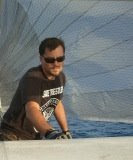Friday, March 20, 2009
Grain Fish (Step 3) - the Chine Log ...I'm Glad My Mother Taught Me How To Iron


This part is probably the most interesting and unexpected part of the building process at this point. For myself, this part seemed to be the most difficult next step. But hopefully you'll find that it's really not once you get started. Just release some steam if you get frustrated. Well, or at least literally release some steam.....this step requires a clothes iron. Honestly, this part is not as hard as it might seem. Just follow directions from the manual and thoroughly read the recommended appendix reading in the chapter. Read it more than once if it helps. It's important to understand the points that tell you what to avoid. Once you read and start working, you'll figure out what to avoid soon enough. Make sure to keep your rag damp, and steam the iron. You're running the iron up and down the chine log (Note: before you do this step, make sure you adequately carve the notches in the frame. Make sure there is enough room in the notches to make the chine log true with the exterior edge of the frame. You'll discover that the chine log is surprisingly flexible with heat, and will for the most part easily take the shape you're looking for. Make sure to use your c-clamps, or pvc clamps as you heat the chine log. The clamps are what will keep the new shape of the chine log in place. Once the chine logs are heated and clamped down under the notches of the frame on both sides (note: again, make sure the chine logs are true with the frame, and avoid kinks!), and then go grab a cold beer!
Grain Fish (Step 2) - Gluing the Frame

Gluing the frame to the planks. This is a fairly simple step for anyone who has already committed to building a Grain board, so I won't go into details. The trickiest part is not trying to mold the bottom to take the shape of the frame. If you have an adequate rocker table already built, you simply let the mechanical design of the table be a vice system for the board. Clamp down, let it bend and take shape, and clamp down some more. Just think of it as making the bottom of the board turn into the bottom exterior shape of the frame using one big vice system. The trickiest part of this step is making sure the keel stays straight, and not stressing the wood too much at the nose. And remember to keep your lines true. Don't forget about your original pencil markings. Remember that the keel is the center for the entire length of the board, so be accurate. It is one very important part for determining other lines of the board.
Subscribe to:
Posts (Atom)













